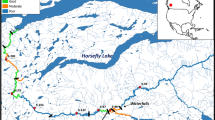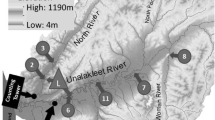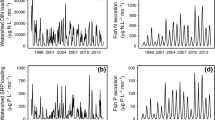Abstract
Spawning salmon deliver nutrients (salmon-derived nutrients, SDN) to natal watersheds that can be incorporated into terrestrial and aquatic food webs, potentially increasing ecosystem productivity. Peterson Creek, a coastal watershed in southeast Alaska that supports several species of anadromous fish, was sampled over the course of a storm during September 2006 to test the hypothesis that stormflows re-introduce stored SDN into the stream. We used stable isotopes and PARAFAC modeling of fluorescence excitation–emission spectroscopy to detect flushing of DOM from salmon carcasses in the riparian zone back into a spawning stream. During the early storm hydrograph, streamwater concentrations of NH4–N and total dissolved phosphorus (TDP), the fluorescent protein tyrosine and the δ15N content of DOM peaked, followed by a rapid decrease during maximum stormflow. Although δ15N has previously been used to track SDN in riparian zones, the use of fluorescence spectroscopy provides an independent indicator that SDN are being returned from the riparian zone to the stream after a period of intermediate storage outside the stream channel. Our findings further demonstrate the utility of using both δ15N of streamwater DOM and fluorescence spectroscopy with PARAFAC modeling to monitor how the pool of streamwater DOM changes in spawning salmon streams.



Similar content being viewed by others
References
Bartz KK, Naiman RJ. 2005. Effects of salmon-borne nutrients on riparian soils and vegetation in southwest Alaska. Ecosystems 8:529–45
Ben-David M, Hanley TA, Schell DM. 1998. Fertilization of terrestrial vegetation by spawning Pacific salmon: the role of flooding and predator activity. OIKOS 83:47–55
Bilby RE, Ward JW. 1991. Characteristics and function of large woody debris in streams draining old-growth, clear-cut, and second-growth forests in southcentral Washington. Can J Fish Aquat Sci 48:2499–508
Bilby RE, Frassen BR, Bisson PA. 1996. Incorporation of nitrogen and carbon from spawning coho salmon into the trophic system of small streams: evidence from stable isotopes. Can J Fish Aquat Sci 53:164–73
Bilby RE, Beach EW, Fransen BR, Walker JK, Bisson PA. 2003. Transfer of nutrients from spawning salmon to riparian vegetation in western Washington. Trans Am Fish Soc 132:733–45
Boyer EW, Hornberger GM, Bencala KE, McKnight DM. 1997. Response characteristics of DOC flushing in an alpine catchment. Hydrol Process 11:1635–47
Bustard DR, Narver DW. 1975. Aspects of the winter ecology of juvenile coho salmon and steelhead trout. J Fish Res Board Can 32:667–80
Chaloner DT, Martin KM, Wipfli MS, Ostrom PH, Lamberti GA. 2002. Marine carbon and nitrogen in south-eastern Alaskan stream food webs. Evidence from artificial and natural streams. Can J Fish Aquat Sci 59:1257–65
Drake DC, Naiman RJ, Bechtold JS. 2006. Fate of nitrogen in riparian forest soils and trees: an 15N tracer study simulating salmon decay. Ecology 87(5):1256–66
Gende SM, Quinn TP, Wilson MF. 2001. Consumption choice by bears feeding on salmon. Oecologia 127:372–82
Gende SM, Edwards RT, Wilson MF, Wipfli MS. 2002. Pacific salmon in aquatic ecosystems. BioScience 52(10):917–28
Gende SM, Miller AE, Hood E. 2007. The effects of salmon carcasses on soil nitrogen pools in a riparian forest of southeastern Alaska. Can J For Res 37:1194–202
Green SA, Blough NV. 1994. Optical absorption and fluorescence properties of chromophoric dissolved organic matter in natural waters. Limnol Oceanogr 39:1903–16
Hellfield JM, Naiman RJ. 2006. Keystone interactions: Salmon and bear in riparian forests of Alaska. Ecosystems 9:167–80
Hicks BJ, Wipfli MS, Lang DW, Lang ME. 2005. Marine-derived nitrogen and carbon in freshwater-riparian food webs of the Copper River Delta, southcentral Alaska. Oecologia 144:558–69
Hilderbrand GV, Hanley TA, Robbins CT, Schwartz CC. 1999. Role of brown bears (Ursus arctos) in the flow of marine nitrogen into a terrestrial ecosystem. Oecologia 121:546–50
Hinton MJ, Schiff SL, English MC. 1998. Sources and flowpaths of dissolved organic carbon during storms in two forested watersheds of the Precambrian Shield. Biogeochemistry 41:175–97
Hood E, Fellman JB, Edwards RT. 2007. Salmon influences on dissolved organic matter in a coastal temperate brownwater stream: an application of fluorescence spectroscopy. Limnol Oceanogr 52(4):1580–7
Kline TC Jr, Goering JJ, Mathisen OA, Poe PH, Parker PL, Scalan RS. 1993. Recycling of elements transported upstream by runs of Pacific Salmon: II. δ15N and δ13C evidence in the Kvichak River watershed, Bristol Bay, southwestern Alaska. Can J Fish Aquat Sci 50:2350–65
Maie N, Scully NM, Pisani O, Jaffe R. 2007. Composition of protein-like fluorophore of dissolved organic matter in coastal wetland and estuarine ecosystems. Water Res 41:563–70
McGlynn BL, McDonnell JJ. 2003. Role of discrete landscape units in controlling catchment dissolved organic carbon dynamics. Water Resour Res 39(4). DOI 10.1029/2002WR001525
Minakawa N, Gara RI. 1999. Ecological effects of a chum salmon spawning run in a small stream of the Pacific Northwest. J Fresh Ecol 14(3):327–35
Mitchell NL, Lamberti GA. 2005. Responses in dissolved nutrients and epilithon abundance to spawning salmon in southeast Alaska streams. Limnol Oceanogr 50:217–27
Murphy J, Riley JP. 1962. A modified single solution method for the determination of phosphate in natural waters. Anal Chim Acta 27:31–6
O’Keefe TC, Edwards RT. 2003. Evidence for hyporheic transfer and removal of marine-derived nutrients in sockeye streams in southeast Alaska. In: Stockner JG, Ed. Nutrients in salmonid ecosystems: sustaining production and biodiversity. Am Fish Soc Sympos 34:99–107
Quinn TP, Peterson NP. 1996. The influence of habitat complexity and fish size on over-winter survival and growth of individually marked juvenile coho salmon in Big Beef Creek, Washington. Can J Fish Aquat Sci 53:1555–64
Reimchen TE, Mathewson D, Hocking MD, Moran J, Harris D. 2002. Isotopic evidence for enrichment of salmon-derived nutrients in vegetation, soil and insects in riparian zones in coastal British Columbia. Am Fish Soc Sympos 34:59–69
Sarica J, Amyot M, Hare L, Doyon MR, Stanfield LW. 2004. Salmon-derived mercury and nutrients in a Lake Ontario spawning stream. Limnol Oceanogr 49:891–9
Shirvell CS. 1990. Role of instream rootwads as juvenile coho salmon cover habitat under varying streamflows. Can J Fish Aquat Sci 47:852–61
Stedmon CA, Markager S, Bro R. 2003. Tracing DOM in aquatic environments using a new approach to fluorescence spectroscopy Mar Chem 82:239–54
Valderrama JC. 1981. The simultaneous analysis of total nitrogen and total phosphorus in natural waters. Mar Chem 10:109–22
Wilkinson CE, Hocking MD, Reimchen TE. 2005. Uptake of salmon-derived nitrogen by mosses and liverworts in coastal British Columbia. OIKOS 108:85–98
Wipfli MS, Hudson J, Caouette J. 1998. Influence of salmon carcass densities on stream productivity: response of biofilm and benthic macroinvertebrates in southeastern Alaska. Can J Fish Aquat Sci 55:1503–11
Yoder DM, Viramontes A, Kirk LL, Hanne LF. 2006. Impact of salmon spawning on microbial communities in a northern California river. J Fresh Ecol 21:147–55
Acknowledgments
The authors wish to thank Karen Michaels for her assistance with field and laboratory analyses and Jacob Berkowitz, Nick Bonzi, and Erik Norberg for their comments on an earlier version of this manuscript. This study was funded by the U.S. Department of Agriculture National Research Initiative, grant number 2005-35102-16289, the USDA Forest Service, Aquatic and Land Interactions Program, and the Resource Management and Productivity Program at the Pacific Northwest Research Station in Juneau, AK. The use of trade or firm names in this publication is for reader information and does not imply endorsement by the U.S. Department of Agriculture of any product or service.
Author information
Authors and Affiliations
Corresponding author
Rights and permissions
About this article
Cite this article
Fellman, J.B., Hood, E., Edwards, R.T. et al. Return of Salmon-Derived Nutrients from the Riparian Zone to the Stream during a Storm in Southeastern Alaska. Ecosystems 11, 537–544 (2008). https://doi.org/10.1007/s10021-008-9139-y
Received:
Revised:
Accepted:
Published:
Issue Date:
DOI: https://doi.org/10.1007/s10021-008-9139-y




